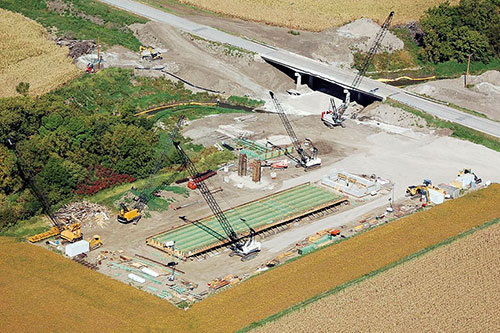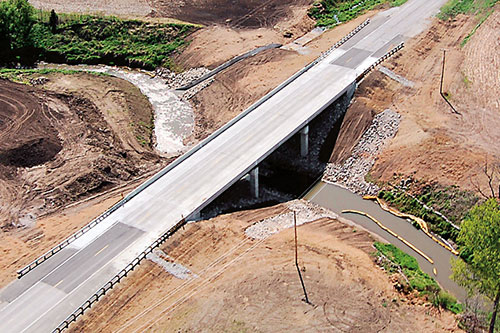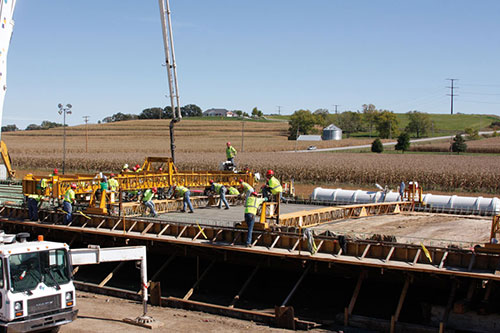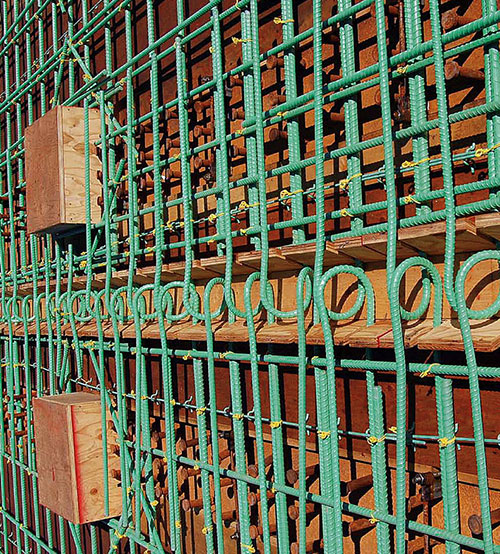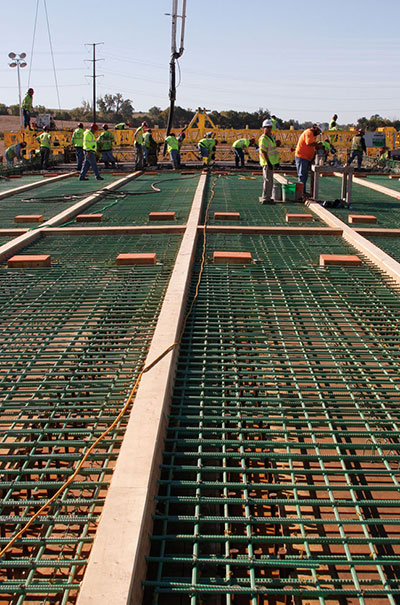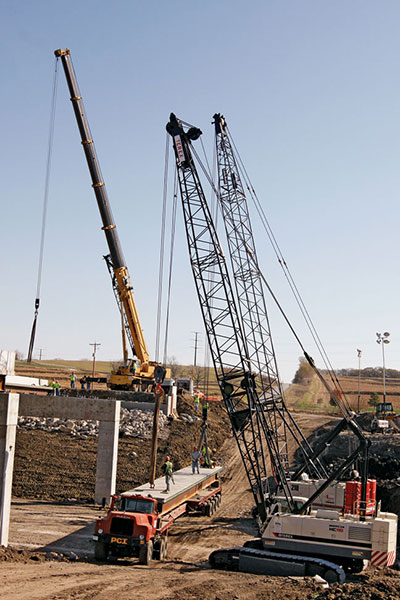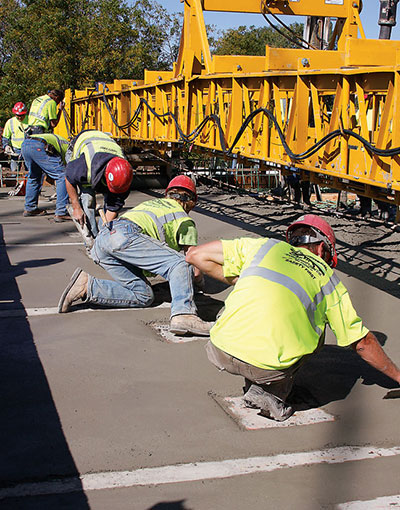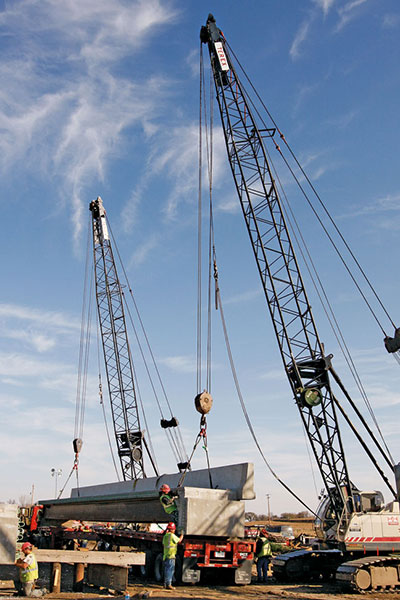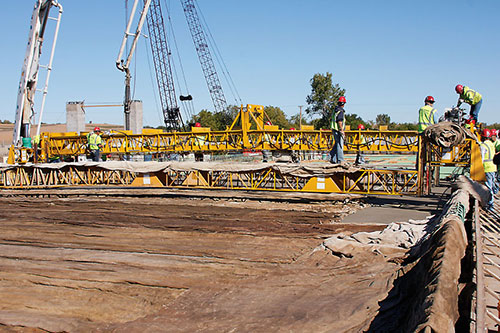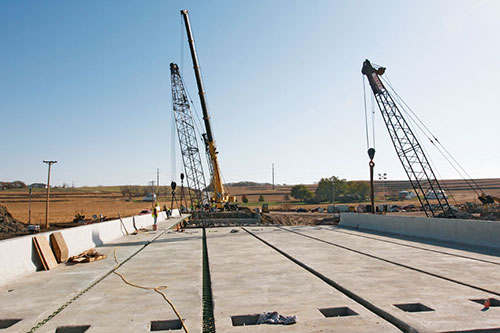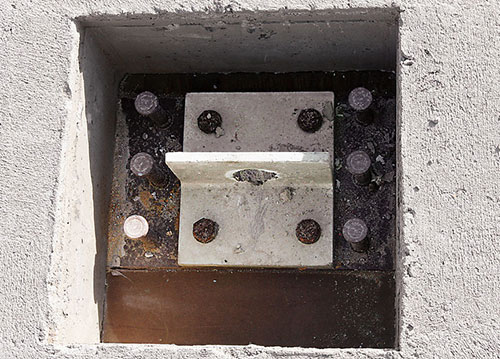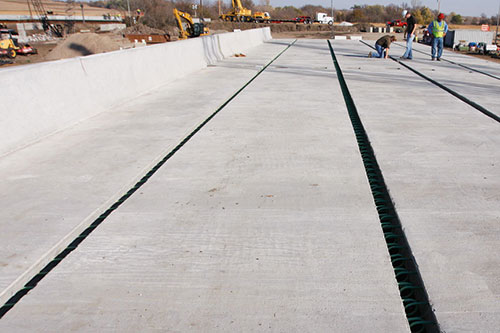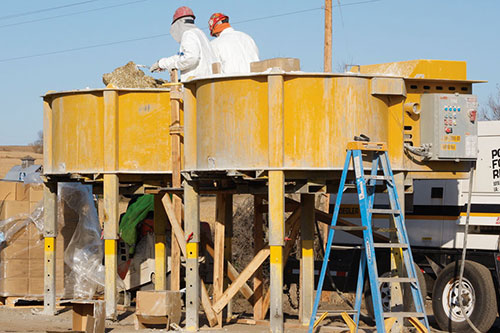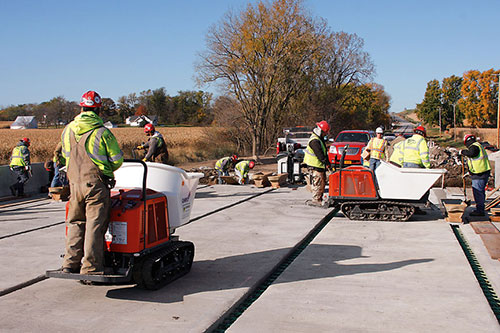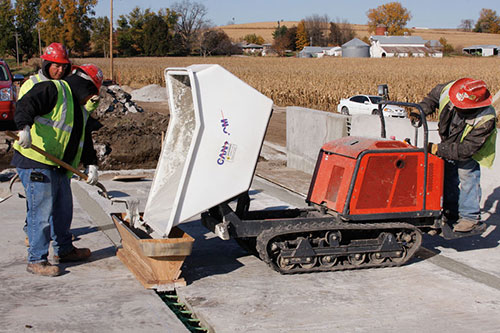GOMACO World Index --- GOMACO World 40.1 - June 2012
A 14-Day Bridge Building Challenge
The new bridge deck was built on falsework in a corn field right next to the road, and it was finished with a GOMACO C-450 cylinder finisher, just like any other bridge deck.
It was a 14-day bridge-building challenge on a rural road in Iowa... a test project with many different facets and numerous challenges. A test where engineers didn't even know if the design configurations were possible in the severely limited timeframe. The project's success, or failure, would be watched by the entire construction industry and the contractor winning the project faced a $22,000 per day incentive/disincentive for completing on time or not.
The Keg Creek Bridge on U.S. Route 6 in Pottawattamie County, six miles (9.7 km) east of Council Bluffs, Iowa, was built in 1953. It was a three-span, concrete haunched girder bridge, 28 feet (8.5 m) wide and 180 feet (54.9 m) long. It was the perfect bridge for the second Strategic Highway Research Program (SHRP 2) accelerated bridge construction (ABC) project.
The purpose of the project was to create a “tool kit” containing standardized plans for modular components, erection concepts, construction specifications and other data that could be applied to other bridge projects. Design firm HNTB Corp. developed the erection concepts.
The ABC test project design called for the prefabrication of almost the entire project, including modular superstructure units with precast barriers and backwalls; precast suspended backwall to create a semi-integral abutment; precast concrete pier caps and columns; precast abutments and wingwalls; and precast concrete approach slabs. Only the bridge's drilled-shaft foundations would be cast in place.
It would also be the first bridge in the United States with a full, moment-resisting ultra-high performance concrete (UHPC) joint at the piers and durable, moment-resisting UHPC joints between deck panels. The UHPC developed for the project had to reach a compressive strength of 10,000 psi (69 MPa) in 48 hours for the connections and deck joints to aid the accelerated construction. The UHPC was tested by Iowa State University in Ames to ensure it met the strength requirement.
Letting the Project–
The Iowa Department of Transportation held a bid letting on the first of a kind project and had seven local contractors submit bids. Godbersen-Smith Construction Company in Ida Grove, Iowa, not only won the bid, but submitted the most unique proposal. Godbersen-Smith's plans didn't include using precast pieces. Instead, they would pre-build all of the pieces on site, build and pour the bridge deck like any other standard bridge deck, and then disassemble and move those pieces to build the new bridge structure.
"This project was envisioned that a precaster would supply the components of the bridge, and a contractor would buy those components and erect them," Kim Triggs, Vice President of Godbersen-Smith Construction, explained. "We looked at it in a different way. Our company builds bridges for a living, that's what we do. This was about 85 percent like every bridge we've ever built, except this bridge wouldn't be a monolithic construction.
"It would be 30 pre-built modules, 18 modules in the deck and 12 in the substructure. Our 15 percent variable was the joints, designing the longitudinal and transverse joints in the deck and then all of the construction joints for the different modules and substructure."
Building the Deck–
Godbersen-Smith Construction rented a section of land adjacent to the Keg Creek Bridge and began their pre-building process. The largest and most challenging aspect was the bridge deck, itself.
"We built falsework for the bridge deck," Triggs said. "We drove wood piling into the ground and we constructed a substructure to support the superstructure. Then, we could build the superstructure all in one piece, much like it was going to be in the final construction. This allowed us to take into account all of the differential deflections between the different components of the bridge, the steel beams, etc. Then we poured the deck exactly like every other bridge that gets poured traditionally."
Traditional except for the fact the deck is being built in the middle of a cornfield in 18 modules with carefully-designed intricate steel in the longitudinal and transverse joints. The joints are designed to be overlapping adjacent steel that would have longitudinal steel run through them during final assembly. The original design had the bars sitting right next to each other with very little tolerance. Godbersen-Smith's method of building the deck all at once ensured each bar was properly placed and tied with its adjacent bar, both while finishing the deck and then when each module was reassembled on the bridge pier.
Each of the joints had to be covered before the pour to keep them from filling with concrete. Each of the modules also had four built-in crane pick points that had to be covered. Godbersen-Smith devised wooden boxes with the sidewalls notched to allow room for the steel rebar. The notches were filled with spray foam before the pour to keep concrete from seeping into the joint from the openings.
Each of the inner bridge deck modules is 7.8 feet (2.4 m) wide and 70 feet (21.3 m) long. The outer modules include a cast-in place parapet wall and are 7.9 feet (2.4 m) wide. The modules combined create a new bridge deck 47.2 feet (14.4 m) wide, 210 feet (64 m) long, and 8.5 inches (216 mm) thick.
GOMACO C-450 Bridge Deck Finisher–
With the structure of the deck built, the joints aligned and sealed, it was time to finish the deck. Godbersen-Smith brought in their GOMACO C-450 bridge deck finisher and lifted it into place for the pour. Before concrete arrived, the entire deck went through a dry run with the C-450.
"We went with kind of an old school, single-drum C-450 and kept it nice and simple while the single-drum kept the profile and the weight of the machine down," Triggs said. "We considered other options for finishing the deck, like a screed, but we wanted the profiling ability of the traditional roller drum bridge deck finisher so we could hold our grade and maintain tolerances. We were very cognizant of the elevations of the longitudinal and transverse forms and the pick points. There were 76 pick points that were for all intents and purposes a 20 inch (508 mm) block out."
Concrete for the deck was a State of Iowa Class C high-performance mix. A pumper truck working on the ground next to the bridge falsework placed the high-performance concrete on the deck in front of the C-450. Twelve finishers working with hand floats finished all of the edges created by the joints.
"There were a lot of joints in this deck so it took a lot of hand finishing, but an edge, is an edge, is an edge," said Triggs. "We had 14 edges the entire length of the deck. Six joints, each with two sides to them, and then the two outside joints. If we were pouring these pieces one at a time in the yard, like a precaster would have done, we still would have had to hand float along those edges. We were just doing them all at the same time."
Average production on the bridge deck was approximately 50 cubic yards (38 m3) per hour. The rate was kept low to accommodate the 12 finishers working behind the C-450, allowing them time to do the necessary handwork. Within 10 minutes of the C-450 making its finishing pass, the concrete deck had to be covered with wet burlap and kept wet for the next 168 hours. The wet cure keeps the temperature of the concrete down and helps minimize potential shrink cracking.
Once the deck reached cure, Godbersen-Smith started removing all of the plywood from the bottom of the deck, removed the wood boxes from the joints and pick points, high-pressure washed the joints to remove the foam, and in general prepared the deck to be moved piece by piece into place over Keg Creek.
Assembling a Jigsaw Puzzle–
Work continued on site as the bridge deck cured. The design called for the bridge piers to be constructed on 95 foot (29 m) deep drilled shafts, six feet (1.8 m) in diameter. They were located outside the footprint of the existing bridge so they could be built under traffic, before the 14-day closure began. Almost all of the concrete work was accomplished before the closure. Godbersen-Smith was also able to build their access roads, place their crane sets, and complete parts of the grading to help minimize the amount of work that had to be accomplished after the bridge closed. Finally, with everything in place, it was time to close the bridge and let the 14-day countdown begin.
First step... demolish the old bridge and haul away the rubble. Then, drive the abutment piling and set the columns. With all the pieces of the bridge sitting beside the creek, it was just a matter of choosing the right pre-built piece, setting it in place, and connecting the pieces together. By day five and six they were setting the abutments and abutment walls and putting the caps in place.
By the afternoon of day six, they were ready to start erecting the deck modules. Five cranes were working on site lifting and moving the modules. The interior bridge modules weigh approximately 56 tons while the exterior modules with the preformed parapet wall weigh approximately 62 tons apiece. Two 80 ton cranes worked together to lift the modules from the falsework onto an expandable, four-axle trailer hooked up to an all-wheel drive Mack tractor.
The modules were transported less than 300 feet (91.4 m) from the falsework to the bridge site where they were driven down into the creek's riverbed. Two 110 ton cranes worked from the riverbed, while a third 210 ton truck crane worked from the road, next to the bridge, to help set the end spans.
"We were able to set those 18 modules in 18 hours over the course of two days," Triggs said. "We had absolutely perfect weather for this, too. It hadn't rained in over two months, so we had nice, dry conditions to be moving these large pieces around on site. The tractor and trailer were able to drive right down to the river bottom and back out again just like we were driving through a parking lot."
Working with the Ultra-High Performance Concrete–
The ultra-high performance concrete was poured on day 11 and was one of the most challenging aspects of the project, simply because it was new and involved a learning curve. The UHPC was mixed on site in two one-half cubic yard (0.4 m3) mobile mixers. Godbersen-Smith poured 24 cubic yards (18.3 m3) of the UHPC in the transverse and longitudinal joints and it took them 10 hours to accomplish the pour.
The mix is very sensitive, very low moisture and extremely susceptible to warm temperatures. Mother Nature continued to be kind to Godbersen-Smith and provided a day with a high temperature of only 56 degrees F (13.3º C). If the UHPC itself reaches a temperature of 70 degrees F (21.1º C) or higher, it won't fluidize.
"It has no aggregate in it, but instead has steel fibers," Triggs explained. "The mix is very low moisture, too, and we weighed every pound of water that went into it. It's very touchy that way and for the exact amount of proportioning that it takes. Its advantage is it gains very, very high psi levels very quickly. We had breaks of over 14,000 psi (97 MPa) in 48 hours with the UHPC. In comparison, a typical bridge deck mix would have a design strength of 4000 psi (28 MPa) in 28 days."
Workers driving concrete buggies transported seven cubic feet (0.2 m3) of the UHPC from the portable mixer out onto the deck. They dumped their load into specially designed wood troughs. The bottom of the troughs were the same six inch (152 mm) width as the joint and wider across the top to be easily dumped into. They were also made to slide, so as the joint filled, the trough could be moved further along the bridge.
As the joints filled with UHPC, they were covered with plywood and a head pressure applied. They wanted the joint to have a slight overbuild, because as the air left the mixture it continued to settle, and they didn't want the joints to be lower than the surface of the concrete deck.
"It's a zero-air content product and that means there's settlement in it," Triggs said. "It's like no other concrete that you've ever been around. It has about a six inch (152 mm) slump and is constantly oozing. We had a 1.7 inch (43 mm) elevation change from the piers to the abutments and it continued to ooze to the low point. We had a minimum of 22 people at the UHPC pour that day, and it was the toughest 24 cubic yards (18.3 m3) of concrete that we've ever poured in our lives."
Grinding the Deck–
The original design of the project had always factored in grinding the deck after it was assembled. The precast pieces the designers had envisioned using, would need to be diamond ground to create the standard bridge deck profile. Godbersen-Smith's pre-built bridge deck would need grinding, as well, just not nearly as much as originally planned by project engineers.
"The way we poured it, like a traditional bridge deck, we had the crown and parabolic curve built into it, and we were also able to compensate for the anticipated deflections in the beams," Triggs explained. "The design was to grind up to 0.5 inch (13 mm) off the whole deck for the parabolic and vertical curve, from barrier wall to barrier wall and abutment to abutment, including the 20 foot (6.1 m) long reinforced concrete bridge approaches. On our deck, they only had to grind between 0.25 to 0.375 inch (6 to 10 mm) maximum off of it. It worked out really good and gave a very nice looking and riding surface."
Grinding took place on day 13, leaving only a few final details. On day 14, the final day of the 14 day completion schedule, the guardrail was installed, the paint lines put down and U.S. Route 6 was reopened to traffic.
"We knew going into this project that it was going to have a lot of visibility and would be a defining project for our industry," Triggs said. "We attacked this project from the very beginning, put in hundreds of man hours on design and brainstorming, and were determined to make it a success. Would we do another one? Absolutely. It was a challenge and it was very interesting. Godbersen-Smith builds bridges, it's what we do for a living."
Two one-half cubic yard (0.4 m3) mobile mixers mixed the ultra-high performance concrete for the bridge's joints.
Challenge Met–
Typically, the Keg Creek project would have involved a road closure and traffic interruption of four to six months. With the ABC approach, that timeframe was cut down to only 14 days. Godbersen-Smith proved the "tool kit" could be a success and other accelerated bridge construction projects are being let this season.
Subscribe to Receive GOMACO World Magazine
